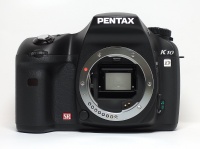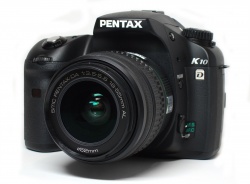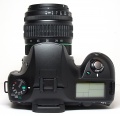Pentax K10D
The Pentax K10D and similar Samsung GX-10 are 10.2 megapixel digital single-lens reflex cameras launched in late 2006. They were developed in a collaboration between Pentax of Japan and Samsung of Korea.
The K10D was announced on September 13, 2006, and released in mid-November 2006, while Samsung announced the GX-10 on 2006-09-21 and it became available on January 1, 2007. The Pentax K20D, successor to the K10D, was officially announced on January 23, 2008.
The K10D has been hailed by Popular Photography and Imaging magazine as "an all-star player," and was named as a finalist for their 2007 "Camera of the Year" award.
Technology and construction
It combines a 10.2 effective megapixel Charge-coupled device (CCD) sensor, coupled with a 22-bit analog-to-digital converter (ADC) and a image stabilization which also provides a dust removal feature to keep dust off the sensor surface. The K10D features a new image processor called PRIME (Pentax Real IMage Engine), which interfaces with DDR2 SDRAM|DDR2 Random access memory (RAM), providing 800MB/s bandwidth. The camera body is dust and weather-resistant featuring 72 seals throughout the camera.
Images can be saved in JPG, Pentax raw image format (PEF) or standard Digital Negative (DNG) format. The Pentax K10D was among the first digital cameras to support the DNG format natively.
Lens mount and compatible lenses

The K10D camera features the Pentax K mount. Like the full-featured KAF2 mount, this has power contacts for the lens and supports power zoom and MTF information transferred from the lens to the body, but lacks the mechanical stop-down coupler necessary for full compatibility with the oldest Pentax K-mount lenses.
In addition, the K10D supports in-lens ultrasonic motors, branded SDM by Pentax. Lenses thus equipped support quieter and faster autofocus operation. Two weathersealed ultrasonic lenses, developed in co-operation with Tokina, have been released.
Like the "crippled" KAF mount used on previous Pentax digital SLRs, the "crippled" KAF2 lacks the mechanism to mechanically sense a lens's aperture ring setting. For that reason, when using the manual aperture ring on K-mount lenses, it is necessary to set the 'Use aperture ring'[1] setting in the 'Custom Menu' to 'Permitted' and use stop-down metering mode (Pentax calls it optical preview) to ensure proper exposure. KA and KAF lenses with aperture rings are fully compatible when the aperture ring is set to automatic ('A'), giving control over the aperture to the camera body.
-
Rear.
-
Top.
-
Left.
Pentax Lenses
- Pentax-DA Lens Operating Manual Including details of KAF, KAF2 and KAF3 mount contacts and couplers. Using the Quick-Shift Focus System, etc.
| Pentax Digital single-lens reflex camera timeline | ||||||||||||||||||||||||||||||||||||||||||||||||||||||||||||||||||||||||||||||||||||||||||||||||||||||||||||||||||||||||||||||||||||||||||||||||||||||||||||||||||||||||||||||||||||||||||||||||||||||||||||||||||||||||||||||||||||||||||||||||||||||||||||||||||||||||||||||||||||||||||||||||||||||||||||||||||||||||||||||||||||||||||||||||||||||||||||||||
|---|---|---|---|---|---|---|---|---|---|---|---|---|---|---|---|---|---|---|---|---|---|---|---|---|---|---|---|---|---|---|---|---|---|---|---|---|---|---|---|---|---|---|---|---|---|---|---|---|---|---|---|---|---|---|---|---|---|---|---|---|---|---|---|---|---|---|---|---|---|---|---|---|---|---|---|---|---|---|---|---|---|---|---|---|---|---|---|---|---|---|---|---|---|---|---|---|---|---|---|---|---|---|---|---|---|---|---|---|---|---|---|---|---|---|---|---|---|---|---|---|---|---|---|---|---|---|---|---|---|---|---|---|---|---|---|---|---|---|---|---|---|---|---|---|---|---|---|---|---|---|---|---|---|---|---|---|---|---|---|---|---|---|---|---|---|---|---|---|---|---|---|---|---|---|---|---|---|---|---|---|---|---|---|---|---|---|---|---|---|---|---|---|---|---|---|---|---|---|---|---|---|---|---|---|---|---|---|---|---|---|---|---|---|---|---|---|---|---|---|---|---|---|---|---|---|---|---|---|---|---|---|---|---|---|---|---|---|---|---|---|---|---|---|---|---|---|---|---|---|---|---|---|---|---|---|---|---|---|---|---|---|---|---|---|---|---|---|---|---|---|---|---|---|---|---|---|---|---|---|---|---|---|---|---|---|---|---|---|---|---|---|---|---|---|---|---|---|---|---|---|---|---|---|---|---|---|---|---|---|---|---|---|---|---|---|---|---|---|---|---|---|---|---|---|---|---|---|---|---|---|---|---|---|---|---|---|---|---|---|---|---|---|---|---|---|---|---|---|---|---|---|---|
| ||||||||||||||||||||||||||||||||||||||||||||||||||||||||||||||||||||||||||||||||||||||||||||||||||||||||||||||||||||||||||||||||||||||||||||||||||||||||||||||||||||||||||||||||||||||||||||||||||||||||||||||||||||||||||||||||||||||||||||||||||||||||||||||||||||||||||||||||||||||||||||||||||||||||||||||||||||||||||||||||||||||||||||||||||||||||||||||||
- ↑ Custom Menu Settings (part 4), PhotographyRulez, Dec 16, 2007



